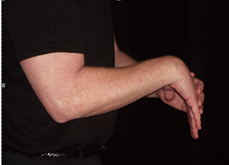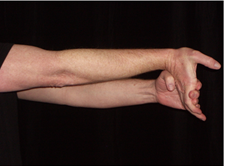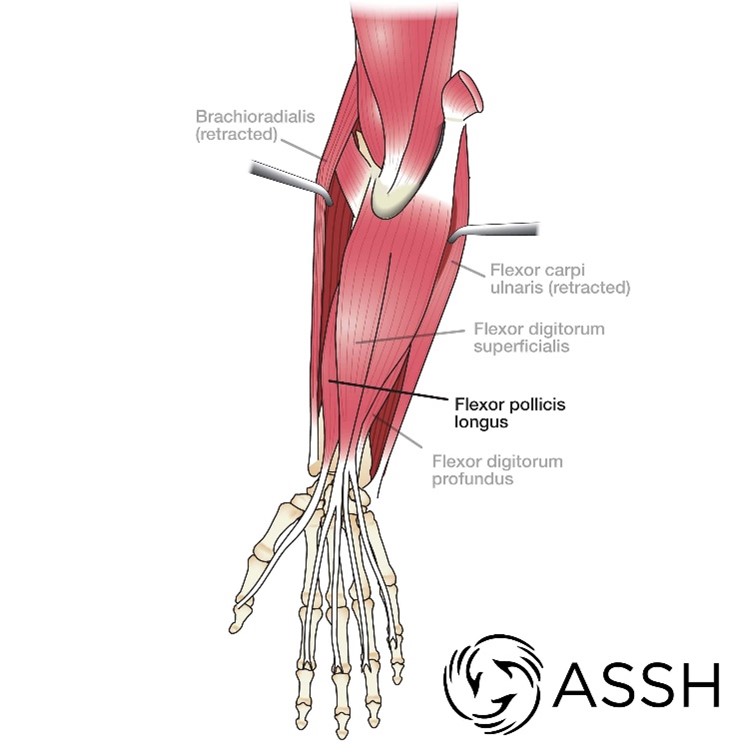Advice from a Certified Hand Therapist: Woodworking Hand Injuries
Advice from a Certified Hand Therapist: Woodworking Hand Injuries
Woodworking is a skill that requires precision and patience. Strong, functional hands are crucial to woodworking and it is important to protect them from potentially dangerous tools and accidents. Knowing the basic anatomy of the human hand and becoming familiar with symptoms for common conditions can be helpful when it comes to protecting yourself from injury during woodworking.
Continuously repeating the same movements during tool use can often lead to repetitive use injuries in the upper extremity. Some common repetitive use injuries that can occur include: tennis elbow (lateral epicondylitis), carpal tunnel syndrome, and cubital tunnel syndrome.
Stretching wrists before and after power tool use may assist with prevention of tight muscles. Typical stretching time would be 30-60 seconds for both wrist flexion and extension.


Tendon gliding can help reduce tightness in the palm as well. This can be done with 10 repetitions before and after tasks.

Also, try to make sure your working conditions are relatively warm, as cold temperatures may reduce mobility and cause increased stress to the hands.
Repetitive wrist extension, especially with the elbow extended, can potentially lead to "tennis elbow", otherwise known as lateral epicondylitis. This leads to pain near the outside of the elbow at the bony prominence during lifting tasks, as well as when extending the wrist backwards. Avoiding prolonged grip with elbow extended can be helpful for this. It may also be helpful to see your local orthopedic doctor or upper extremity therapist for a home exercise program if you feel this has developed.
Vibration from power tools and awkward positions at the elbow and wrist may cause carpal tunnel syndrome and/or cubital tunnel syndrome over time. Carpal tunnel syndrome affects the index, long, and thumb digits. Cubital tunnel syndrome affects the ring and small digits and may cause a numbness and tingling feeling, especially at night. Awkward positions such as prolonged elbow and wrist flexion can exacerbate symptoms and increase likelihood of developing these symptoms. Avoiding lengthy use of power tools by taking rest breaks and avoiding extreme flexion or extension of the wrist and elbows for extended periods of time is helpful to avoid nerve compression.
There are also some more severe injuries to watch out for while woodworking, including tendon and/or vascular injury. You have muscles in both the hand and forearm that function to make our fingers and thumb move. Our thumb has three muscles within the hand that help it to grasp objects, rotate, and flex. We also have muscles that bring our fingers together and spread them apart that are within the hand itself. The muscles in our forearm are the main contributors to finger movement and they are attached by tendons that make our fingers flex and extend. The thumb has a muscle in the forearm that also assists with flexion.

A tendon is a thin portion at the end of a muscle that attaches to the bone. Therefore, when we move our fingers, the muscles responsible for this movement are actually contracting in the forearm, not the finger or hand.
If one of these tendons in our fingers or wrist are cut with a saw or other tool, it is not a simple fix with stitches. This type of injury often requires surgery to repair the delicate tendon. Typically, you would not be able to use the hand functionally for several weeks. Signs of injured tendons include not being able to bend or straighten the finger after cutting or crushing it. Being patient when using saws or other tools is crucial to avoid serious injury and wearing gloves may actually "catch" within the saw, cutting the fingers. This can also apply when hammering a nail, with accidentally hitting the tip of the finger, causing a "droop" of the tip called a mallet finger.
Another sign of a potential hand injury is discoloration or throbbing on the small finger side of the palm. This is known as "hypothenar hammer syndrome." Hypothenar is a medical term which means palm and small finger side of the hand.
This is not a common injury, but when it does occur, it is usually found in individuals who use heavy equipment or power tools. This injury develops over time when there is excessive pressure on the small finger side of the palm, thus limiting blood flow. Decreased blood flow (also known as decreased circulation) can lead to discoloration, clotting, and/or abnormal sensation. Rest breaks from power tools and avoiding pounding or pressure on the palm can assist with prevention of this.
Not all injuries appear significant initially. Something as seemingly small as a splinter can have serious repercussions. It is crucial to watch for signs of inflammation, abnormal or decreased movement, and/or an infection.
If you have any concerns or questions about hand related information, please contact your local hand surgeon or hand therapist.
_______________________________________________________________________
Madisson Miller, MOT, OTR/L, CSCS, CHT is a member of the American Society of Hand
Therapists.
Woodworking is a skill that requires precision and patience. Strong, functional hands are crucial to woodworking and it is important to protect them from potentially dangerous tools and accidents. Knowing the basic anatomy of the human hand and becoming familiar with symptoms for common conditions can be helpful when it comes to protecting yourself from injury during woodworking.
Continuously repeating the same movements during tool use can often lead to repetitive use injuries in the upper extremity. Some common repetitive use injuries that can occur include: tennis elbow (lateral epicondylitis), carpal tunnel syndrome, and cubital tunnel syndrome.
Stretching wrists before and after power tool use may assist with prevention of tight muscles. Typical stretching time would be 30-60 seconds for both wrist flexion and extension.
Tendon gliding can help reduce tightness in the palm as well. This can be done with 10 repetitions before and after tasks.
Also, try to make sure your working conditions are relatively warm, as cold temperatures may reduce mobility and cause increased stress to the hands.
Repetitive wrist extension, especially with the elbow extended, can potentially lead to "tennis elbow", otherwise known as lateral epicondylitis. This leads to pain near the outside of the elbow at the bony prominence during lifting tasks, as well as when extending the wrist backwards. Avoiding prolonged grip with elbow extended can be helpful for this. It may also be helpful to see your local orthopedic doctor or upper extremity therapist for a home exercise program if you feel this has developed.
Vibration from power tools and awkward positions at the elbow and wrist may cause carpal tunnel syndrome and/or cubital tunnel syndrome over time. Carpal tunnel syndrome affects the index, long, and thumb digits. Cubital tunnel syndrome affects the ring and small digits and may cause a numbness and tingling feeling, especially at night. Awkward positions such as prolonged elbow and wrist flexion can exacerbate symptoms and increase likelihood of developing these symptoms. Avoiding lengthy use of power tools by taking rest breaks and avoiding extreme flexion or extension of the wrist and elbows for extended periods of time is helpful to avoid nerve compression.
There are also some more severe injuries to watch out for while woodworking, including tendon and/or vascular injury. You have muscles in both the hand and forearm that function to make our fingers and thumb move. Our thumb has three muscles within the hand that help it to grasp objects, rotate, and flex. We also have muscles that bring our fingers together and spread them apart that are within the hand itself. The muscles in our forearm are the main contributors to finger movement and they are attached by tendons that make our fingers flex and extend. The thumb has a muscle in the forearm that also assists with flexion.
A tendon is a thin portion at the end of a muscle that attaches to the bone. Therefore, when we move our fingers, the muscles responsible for this movement are actually contracting in the forearm, not the finger or hand.
If one of these tendons in our fingers or wrist are cut with a saw or other tool, it is not a simple fix with stitches. This type of injury often requires surgery to repair the delicate tendon. Typically, you would not be able to use the hand functionally for several weeks. Signs of injured tendons include not being able to bend or straighten the finger after cutting or crushing it. Being patient when using saws or other tools is crucial to avoid serious injury and wearing gloves may actually "catch" within the saw, cutting the fingers. This can also apply when hammering a nail, with accidentally hitting the tip of the finger, causing a "droop" of the tip called a mallet finger.
Another sign of a potential hand injury is discoloration or throbbing on the small finger side of the palm. This is known as "hypothenar hammer syndrome." Hypothenar is a medical term which means palm and small finger side of the hand.
This is not a common injury, but when it does occur, it is usually found in individuals who use heavy equipment or power tools. This injury develops over time when there is excessive pressure on the small finger side of the palm, thus limiting blood flow. Decreased blood flow (also known as decreased circulation) can lead to discoloration, clotting, and/or abnormal sensation. Rest breaks from power tools and avoiding pounding or pressure on the palm can assist with prevention of this.
Not all injuries appear significant initially. Something as seemingly small as a splinter can have serious repercussions. It is crucial to watch for signs of inflammation, abnormal or decreased movement, and/or an infection.
If you have any concerns or questions about hand related information, please contact your local hand surgeon or hand therapist.
_______________________________________________________________________
Madisson Miller, MOT, OTR/L, CSCS, CHT is a member of the American Society of Hand
Therapists.
Find a hand surgeon near you
Using this search tool means you agree to the user agreement and disclaimer.